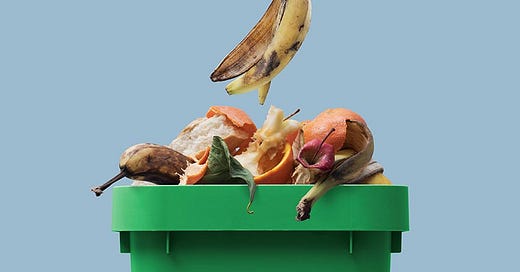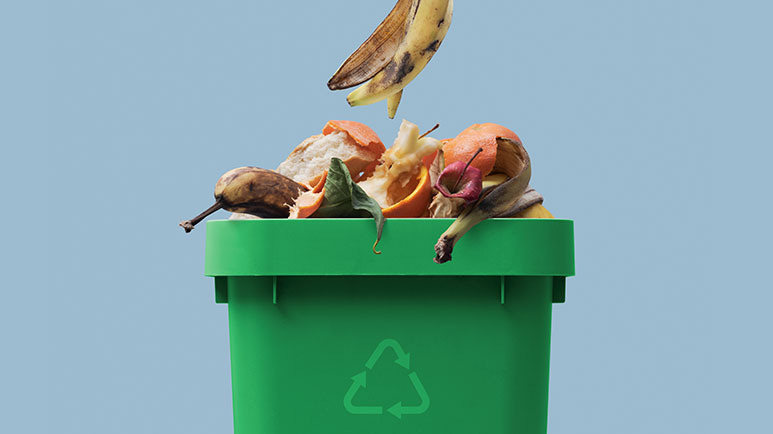The Next Food Frontier — Recycling
Plastic bottles, glass jars and aluminum cans are not the only items that can be recycled. Recycling organic material, including food & yard waste, via composting is the next generation of recycling.
STORY AT-A-GLANCE
Organic waste, including food and yard waste, makes up the largest share of U.S. trash, more than any other material, including paper and plastic
Residential food composting programs have been tested in a number of U.S. cities, including New York City, Austin and Milwaukee, and more than 180 communities collect food waste from residences
Compost is a valuable resource that reduces fertilizer use while enhancing the chemical, physical and biological properties of soil
Editor's Note: This article is a reprint. It was originally published January 17, 2017.
Many Americans dutifully recycle their plastic bottles and newspapers, but when it comes to food and yard waste toss them directly in the trash.
While it seems like a banana peel here and pile of spoiled greens there would do little in the way of environmental harm, food waste is actually the second largest component of waste sent to U.S. landfills, making up 18% of the waste stream, according to the U.S. Environmental Protection Agency (EPA).1
Yard trimmings make up another 7%. When combined, this organic waste makes up the largest share of U.S. trash, more than any other material, including paper and plastic.
In all, the food waste alone amounts to more than 30 million tons of waste entering U.S. landfills every year. This is particularly tragic since food and yard waste is easily recycled, though not by placing it in a recycling bin at your curb.
It's actually quite simple to "recycle" these types of organic materials right in your own backyard. It's called composting, and it's being taken up on a large scale slowly but surely across the U.S.
Large-Scale Composting Is Catching On
At the Prince George composting facility in Maryland, which already processed thousands of tons of yard waste daily, food scraps are accepted.
In a project that started several years ago, twenty-five commercial customers have been sending food scraps (and even pizza boxes), such as coffee grinds and vegetable peels, to be naturally composted into a valuable natural resource. According to The Christian Science Monitor:2
"… [A] dearth of landfill space, friendly public policies, social pressures and other factors are beginning to spur industrial-scale efforts to turn trashed food into something useful.
For example: California, Connecticut, Massachusetts, Vermont and Rhode Island have banned some large food producers and other large businesses, such as convention centers and supermarkets, from throwing away food, making composting a popular alternative."
Curbside recycling programs will soon expand to collect food waste alongside your paper towel rolls (and soiled paper products, including paper towels, are often compostable, too).
Residential food composting programs have been tested in a number of U.S. cities, including New York City, Austin and Milwaukee, and more than 180 communities collect food waste from residences.3 Many of the programs started out by allowing residents to add food scraps to their yard waste recycling bins.
In the city of Oak Park, Illinois, for instance, a residential food scraps program was tested in 2012 and expanded as a subscription service in 2013. By 2017, about 740 households and six multi-family buildings participate.
The organics recycling service costs an additional $14 per month and is diverting an estimated 10 pounds of food scraps and soiled paper per household/per week from landfills to composting.4
Composting Yields Impressive Benefits
Composting food waste is about far more than simply conserving limited landfill space. For starters, when organic materials sit in landfills, bacteria break them down into methane gas, which is the third largest source of U.S. emissions.5 So cutting back on the amount of organics entering landfills cuts back on these emissions.
Also important, food waste can be turned into a valuable resource — compost — that is otherwise wasted. Although often described as fertilizer, compost is actually most valued for its organic matter content.
While it reduces fertilizer use, it also enhances the chemical, physical and biological properties of soil, according to the Institute for Local Self-Reliance (ILSR).6 Topsoil loss and erosion are major concerns in the 21st century, leading to watershed problems and threatening "our ability to sustain life on Earth," ILSR noted.
"Advancing composting and compost use is a key sustainability strategy to create jobs, protect watersheds … improve soil vitality and build resilient local economies," they continued. In their 2014 report, "The State of Composting in the U.S.," ILSR highlighted many of the benefits of amending soil with compost:7
Improved soil quality and structure
Erosion and sedimentation control
Improved water retention
Reduced chemical needs
Cutting non-point source pollution
Composting Helps Soil Absorb Carbon
The Marin Carbon Project in Northern California, which began in 2008, revealed how valuable composting is to communities. Researchers applied one-half inch of compost over land used for grazing cattle and have been observing the land for more than a decade.8
Forage on the composted areas increased by 40% to 70%, year after year. The change was so dramatic that the cattle herds tended to feed primarily in the areas that had been treated with compost.
The project also revealed increases in the amount of water-holding capacity in the soil, which are a major benefit in the drought-prone area.
Also significant, increases in soil carbon were also noted. It's estimated that one-third of the surplus carbon dioxide in the atmosphere stems from poor land management processes that contribute to the loss of carbon, such as carbon dioxide, from farmlands.9
So-called carbon farming is a simple premise that involves using agricultural methods like composting that naturally trap carbon dioxide in the ground (for decades, centuries or more), while also absorbing it from the air.
The process, known as "carbon sequestration," could help mitigate greenhouse gas emissions while regenerating the soil and more.
Other benefits, including increased plant productivity and reduced need for commercial feeds, were also seen. If it can be done in California, it can be done elsewhere as well, with radical benefits to the environment.
Compost Tea for Improving Soil Health
Green Pastures Farm in Rucker, Missouri, is another poster child for composting. Through the use of compost, rotational grazing and other natural methods for improving soil biology, they raise grass fed beef and other livestock without the use of any chemical fertilizers or herbicides.
The use of compost tea, which is basically the liquid from compost steeped in water, proved to be particularly beneficial for increasing soil health. Farmer Greg Judy told Holistic Management International:10
"One pound of properly made compost can make 300 gallons of compost tea. You only need 30 gallons/acre of the tea if the soil is completely broken … roots don't die back when a plant is grazed if the soil is healthy. The plant just exudes food for the soil life through the roots.
It still maintains its root structure and can still access water and minerals below ground to grow more forage above ground! This opens up a whole new way of looking at grazing, particularly in drought-prone areas.
The compost tea can improve any soil, anywhere, so the possibilities are amazing! Since land is the biggest expense in ranching, if you can grow double your forage with compost tea, you've just bought yourself a whole new ranch for very little money."
Barriers to Large-Scale Composting
With immense benefits and potential to transform the way food waste is handled in the U.S., why haven't more large-scale composting programs been started? As ILSR pointed out:11
"The potential to expand composting is enormous. The U.S. disposes of 164 million tons of garbage per year. Almost half the materials Americans discard — food scraps, yard trimmings and soiled paper — is compostable."
However, there are many barriers standing in the way of expansion (none of which are insurmountable). Richard Flammer, a composting consultant, told the San Diego Reader:12
"… [F]actors including low 'tip fees' at local landfills, a lack of composting facilities near population centers, lack of coordination among a host of different waste service providers and 'poorly-written or nonexistent zoning and local land use restrictions' all contribute to a relatively low participation rate in composting across the county."
In many areas, it still costs more to compost food waste than it does to throw it in the landfill (although the opposite is true in some cities). There's also a catch-22 going on, in which firms are reluctant to invest in composting facilities until they know they'll have a guaranteed supply of organic material to support it. However, city governments are reluctant to begin collecting the organic material until they know there's a facility to compost it.13
You Can Compost in Your Own Backyard
Ideally, city-wide recycling programs will soon expand to collect food and yard waste along with other recyclables, with the organic material being sent to composting facilities. You don't, however, need to wait for this to happen to begin reaping the benefits of compost in your own backyard.
You can compost in a pile, in a box or a ready-made tumbling composter bin. The latter is very convenient but can cost upward of $200. Less expensive options include making your own from wood, recycled plastic, or even chicken wire.
Tumblers (rotating drums) are great because they make aeration a breeze — all you have to do is turn the drum every few days, which takes less effort than turning a pile with a fork or shovel. They are also much faster to compost; you can get great compost in as little as one to two weeks, while the piles will take many months to digest.
Many local municipalities also have bins available for a reasonable price. For the best moisture and temperature regulation, select bins that hold at least one cubic yard.
Your compost zone should be conveniently located, as close as possible to your source of raw materials (kitchen scraps, lawn clippings or soiled paper products) where it won't be too much of an eyesore. If you are using piles or bins, I recommend having two of them as then you'll have a place to put fresh scraps while one full "batch" of compost finishes curing. Happy composting!
Disclaimer: The entire contents of this website are based upon the opinions of Dr. Mercola, unless otherwise noted. Individual articles are based upon the opinions of the respective author, who retains copyright as marked.
The information on this website is not intended to replace a one-on-one relationship with a qualified health care professional and is not intended as medical advice. It is intended as a sharing of knowledge and information from the research and experience of Dr. Mercola and his community. Dr. Mercola encourages you to make your own health care decisions based upon your research and in partnership with a qualified health care professional. The subscription fee being requested is for access to the articles and information posted on this site, and is not being paid for any individual medical advice.
If you are pregnant, nursing, taking medication, or have a medical condition, consult your health care professional before using products based on this content.






